Home Based Wireless Health Monitoring System give a detailed insight into design and implementation of the system. Biomedical engineering is the application of engineering principles and techniques to the medical field. The development of biomedical engineering is responsible for improving healthcare diagnosis ,monitoring and therapy. The novel idea behind Health line is to provide quality health service to one and all.The idea is driven by the vision of a cable free biomedical monitoring system. On body sensors monitor the vital parameters (blood pressure, ECG, temperature and heart beat rate) and transmits the data to doctors end via wireless communication network. Periodic health monitoring (or preventative care) allows people to discover and treat health problems early, before they have consequences. Especially for risk patients and long term applications, such a technology offers more freedom, comfort, and opportunities in clinical monitoring.The very idea of the health line is to provide service to community. Chronic diseases have a significant influence on healthcare costs and are common among people. Changes in demographic structure and lack of health and social care personnel force us to study new innovations, which could o er a relief to these challenges. Seniors have to make frequent visits to their doctor to get their vital signs measured. The vital signs include Pulse rate ,Blood pressure,Body temperature ,ECG,etc.
Keywords |
| Body Sensor Monitor, Vital Parameters, wireless sensor network. |
INTRODUCTION |
| The goal of Home Based Wireless Health Monitoring System is to develop a low cost, low power, reliable,
non-intrusive,and non-invasive vital signs monitor which collect different type of body parameters and the sampled
parameters are wireless transmitted to a health care professional.The main part of our project is to design and build a
sensing and data conditioning system to acquire accurate heart rate, ECG, blood pressure, and body temperature
readings. After processing of data we have to find a proper method of transmission and signal display.Constant
monitoring is also required in case of hospitals where the patients must be under active medical care or under continual
observation for longer duration. Even though the patient is not in dangerous situation, the doctors would still need
confirmation on their health. In recent times, the expenses for hospitalization and medical care are unimaginably high
and expensive. Hence the health policies in countries like USA, UK has shifted its focus from providing reactive, acute
care to providing preventive care outside the hospital. |
METHODOLOGY |
| The scope of this project is to build a device for individuals over the age of 65 years. This limitation is added
to simplify our project and ensure it is achievable with the restricted time and resources available. Since the target
subjects for this device are individuals over 65 years of age, the most important feature of this device is that it must be
easy to use.The methodology adopted for this project is to use non-invasive sensors to measure heart rate, blood
pressure, ECG, and body temperature. The sensors used are inexpensive and are easy to use by the patient. Signal
conditioning circuits are designed to filter and amplify the signals to provide desired output. All the components used
in these circuits are low powered and inexpensive. The acquired data is sent to PC of health care professional after
analog-to-digital conversion (ADC). |
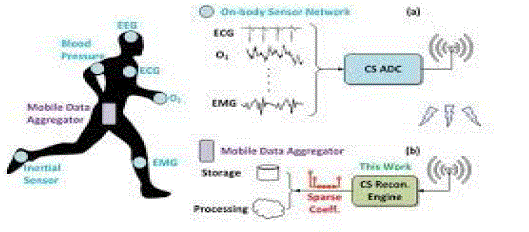 |
| In spite of the improvement of communication link and despite all progress in advanced communication technologies,
There is still very few functioning commercial Wireless Monitoring Systems, which are most off-line, and there are
still a number of issues to deal with. Therefore, there is a strong need for investigating the possibility of design and
implementation of an interactive real-time wireless communication system. In our project, a generic real-time wireless
communication system was designed and developed for short and long term GSM Based remote patient monitoring
applying wireless protocol. |
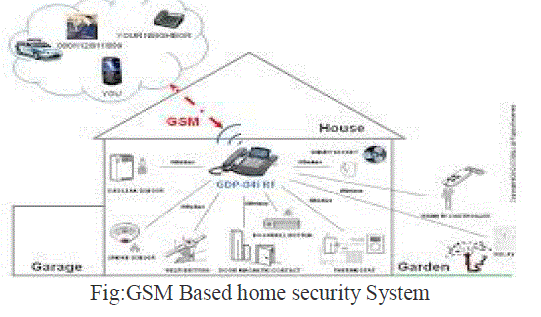 |
| The primary function of this system is to monitor the Heart Beat and temperature of the Patient and the Data collected
by the sensors are sent to the Microcontroller. Microcontroller and then display the result over the LCD display. If there
is a dangerous change in patient's status a message is sent to the doctor’s mobile. Cost reduction pressures and the need
for shortened in-patient stays are promoting the use of wireless patient monitoring systems in hospitals & Life line
Ambulances. Their contribution to better process management, superior flexibility and increased efficiency within
hospitals is further underlining the appeal of wireless networking options for patient monitoring systems. |
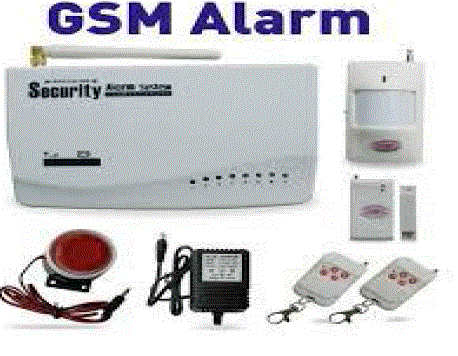 |
| This device can be used in lifeline ambulance to monitor patient’s conditions before reaching hospitals. By
this doctor can understand the present condition of the patient before reaching the hospital. Thus doctor can arrange for
any immediate necessities for patient. This can also be used in ICU, CCU, MICU & POCCU in hospitals where the
condition & pulse rate monitoring of patient is necessary. With the advanced flexible PCB technology & SMT we can
make devices suitable to embed with patient’s body so that doctor can monitor the patient even if he is in the remote
area. |
SYSTEM DESIGN |
| The Health Tracker 2000 combines wireless sensor networks, existing RFID (Radio Frequency Identification) and Vital
Sign Monitoring technology to simultaneously monitor vital signs while keeping track of the users’ location. The use of
wireless technology makes it possible to install the system in all types of homes and facilities.Radio frequency waves
can travel through walls and fabric, sending the vital sign and location information to a central monitoring computer via
a miniature transmitter network. Such information can easily be accessed from any location over the Internet. |
| (A)RF Wireless Transceiver and Receiver |
| An RF wireless transceiver system is designed in this case study. The transmitter system is a onestage
Intermediate frequency (IF) superheterodyne transmitter, with a baseband frequency of 300MHz. The receiver uses a
two stage IF downconverter, downconverting the RF first to1000MHz and finally to 300MHz. The received power at
PORT2 is 10.402dBm. Analysesshowed that as the link distance increased from 0.5-2.5Km, the received power
decreased from16.054-2.538 dBm; the decrease is almost linear. Also, a linear increase in Transmitter antennagain
(TxGain) with received power (IFout). From budget power gain analysis, link1 showed thehighest loss in power while
amp2 showed the highest gain. Link1 and Amp2 showed a highcontribution in noise figure (6.380 and 19.015) to the
system. |
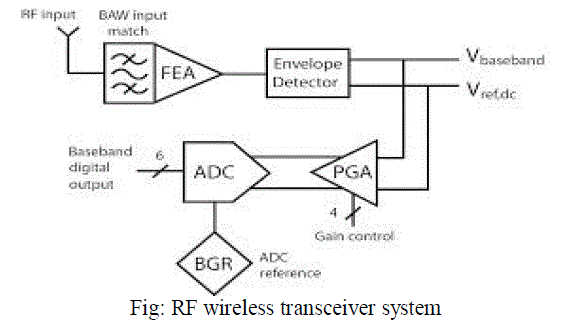 |
| A transceiver is any device comprising both a transmitter and a receiver which are combined andshare common
circuitry or a single housing. The figure below shows the block diagram of an RFwireless Transceiver, showing the
transmitter, wireless link and the receiver. Transceivers enableduplex communication modes (half or full). Various
applications of transceivers includeWLANs, GPS, RF-Identification systems (RF-IDs), Home Satellite
Networks,GSM,Satellite Phones ,Blue tooth devices , Pagers etc.Transceivers circuits are implemented with IC chip in
a drive towards miniaturaization ,cost and linearity. |
| (B) MEMS WIRELESS MONITORING SYSTEM |
| Norwood, MA (06/04/2013) - Analog Devices, Inc. ( ADI) today introduced a wireless vibration sensing
system that allows industrial systems operators to remotely monitor production equipment health, improve system
performance, and reduce maintenance costs. The new networked system includes the ADIS16229 iSensor® wireless
vibration sensor node, which combines dual-axis digital MEMs (micro-electro mechanical systems) acceleration
sensing with advanced frequency-domain and time-domain signal processing. The sensing system also includes the
ADIS16000 gateway node, which supports up to six ADIS16229 sensors at one time using a proprietary wireless protocol, managed through an SPI interface compatible with most embedded processor platforms. The wireless
function enables the remote monitoring of equipment in hard to reach or dangerous locations, while the vibration
sensing and detection node is easy to install into existing infrastructure and allows continual monitoring that can be
used to evaluate equipment performance and schedule predictive maintenance. |
| The primary driver of predictive maintenance is the reduction of factory system downtime, which currently
relies on periodic off-line performance trend analysis,” said Bob Scannell, iSensor business development manager,
MEMS/Sensors Group, Analog Devices. “With MEMS-based vibration sensors that continuously monitor machine
tools, turbines, pumps, conveyors, compressors, engines and other equipment, factory operators receive real-time
statistical performance data and process control feedback that allow them to prevent costly system shut-downs.” |
| Download data sheet, view product page, order samples and evaluation boards: ADIS16229 To learn more
about improving industrial control using MEMS inertial sensors visit: MEMS Sensors More About the ADIS16229 and
ADIS16000 The ADIS16229 is a complete sensor node featuring a MEMs vibration sensor, an RF transceiver, and
embedded frequency and time domain signal processing. The device captures shifts in equipment performance through
direct analysis and reporting of the frequency-domain signature using a 512-point, real-valued FFT (fast Fourier
transform), FFT magnitude averaging, and programmable spectral alarms. An FFT record storage system offers users
the ability to track changes over time and capture FFTs with multiple decimation filter settings. |
| The ADIS16000 gateway node wirelessly connects with up to six sensor nodes, and then interfaces with most
embedded processor platforms, through a standard SPI interface. |
| ADIS16229 and ADIS16000 Key Features |
| (i) MEMS wireless vibration system: 862 MHz to 928 MHz |
| (ii) Sensor node (ADIS16229): Dual-axis, ±18g MEMS accelerometer |
| (iii) 5.5k-Hz resonant frequency |
| (iv) Sample rate up to 20 kSPS |
| (v) Programmable wake-up capture, update cycle times |
| (vi) Internal self-test, with status flags |
| (vii) Single-supply operation: 3.0 V to 3.6 V |
| (viii) Gateway node (ADIS16000) |
| (ix) SPI to RF function- Manage up to 6 sensor nodes |
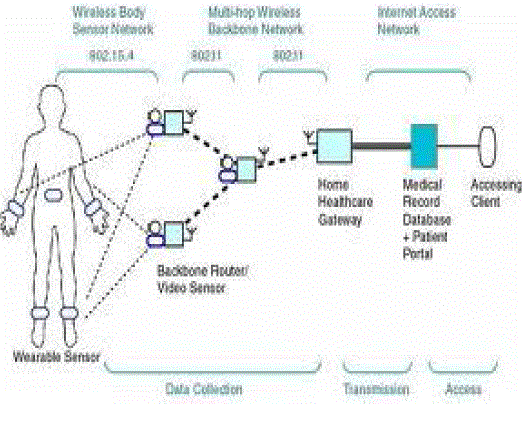 |
CONCLUSION |
| A wireless communication system is designed and developed for remote patient monitoring. The primary
function of this system is to monitor the temperature of a patient’s body, and display the same to the doctor through RF
communication. In this proposed system transmitting module continuously reads patient’s body temperature through a
digital temperature sensor, displays it on the LCD screen and sends it to the microcontroller which transmits the
encoded serial data over the air by RF (radio frequency) through an RF module.At the receiving end, a receiver is used
to receive the data, decode it and feed it to another microcontroller which is then displayed on an LCD screen. |
| The receiver module is kept in the doctor’s chamber to continuously display the patient’s body temperature
wirelessly. This paper presents a newly designed integrated wireless monitoring system that supports real-time data
acquisition from multiple wireless sensing units. The selected wireless transceiver consumes relatively low power and
supports long-distance peer-to-peer communication. In addition to hardware, embedded multithreaded software is also
designed as an integral component of the proposed wireless monitoring system. A direct result of the multithreaded
software paradigm is a wireless sensing unit capable of simultaneous data collection, data interrogation and wireless
transmission. A reliable data communication protocol is designed and implemented, enabling robust real-time and nearsynchronized
data acquisition from multiple wireless sensing units |
References |
- Arms, S. W., Townsend, C. P., Galbreath, J. H. and Newhard, A. T. July 7 âÃâ¬Ãâ 9 2004. âÃâ¬ÃÅWireless strain sensing networksâÃâ¬ÃÂ.InProceedings of the 2nd European Workshop on Structural Health Monitoring July 7 âÃâ¬Ãâ 9, Munich, , Germany
- Callaway, E. H. Jr. 2004. Wireless Sensor Networks: Architectures and Protocols, New York, , USA: Auerbach.
- Celebi, M. 2002. Seismic Instrumentation of Buildings (with Emphasis on Federal Buildings), Menlo Park, , CA, USA: US Geological Survey (USGS). Report No. 0- 7460-68170
- Chang, P. C., Flatau, A. and Liu, S. C. 2003. Review paper: health monitoring of civil infrastructure. Struct. Health Monit., 2: 257âÃâ¬Ãâ267.
- Chase, S. March 4 âÃâ¬Ãâ 8 2001. âÃâ¬ÃÅThe role of smart structures in managing an aging highway, Keynote PresentationâÃâ¬ÃÂ. In SPIE 8th Annual International Symposium on Smart Structures and Materials March 4 âÃâ¬Ãâ 8, Newport Beach, , CA, USA
- Churchill, D. L., Hamel, M. J., Townsend, C. P. and Arms, S. W. March 2 âÃâ¬Ãâ 6 2003. âÃâ¬ÃÅStrain energy harvesting for wireless sensor networksâÃâ¬ÃÂ. In Proceedings of SPIE 10th Annual International Symposium on Smart Structures and Materials Edited by: Varadan, V. K. and Kish, L. B. March 2 âÃâ¬Ãâ 6, 319âÃâ¬Ãâ327. San Diego, , CA, USA SPIE v. 5055
- Culler, D. E. and Hong, W. 2004. Wireless sensor networks: introduction. Commun. ACM, 47: 30âÃâ¬Ãâ33.
- Elgamal, A., Conte, J. P., Masri, S., Fraser, M., Fountain, T., Gupta, A., Trivedi, M. and El Zarki, M. September 15 âÃâ¬Ãâ 17 2003. âÃâ¬ÃÅHealth monitoring framework for bridges and civil infrastructureâÃâ¬ÃÂ. In Proceedings of the 4th International Workshop on Structural Health Monitoring Edited by: Chang, F. -K. September 15 âÃâ¬Ãâ 17, 123 130. Stanford, , CA, USA
- Ewins, D. J. 2000. Modal Testing: Theory, Practice, and Application, Hertfordshire, , England: Research Studies Press.
- Farrar, C. R., Sohn, H., Hemez, F. M., Anderson, M. C., Bement, M. T., Cornwell, P. J., Doebling, S. W., Schultze, J. F., Lieven, N. and Robertson, A. N. July 2003. Damage Prognosis: Current Status and Future Needs July, Los Alamos, , NM, USA Los Alamos National Laboratory Report LA-14051-MS
- Glaser, S. D. March 14 âÃâ¬Ãâ 18 2004. âÃâ¬ÃÅSome real-world applications of wireless sensor nodesâÃâ¬ÃÂ. In Proceedings of SPIE 11th Annual International Symposium on Smart Structures and Materials Edited by: Liu, S. C. March 14 âÃâ¬Ãâ 18, 344âÃâ¬Ãâ355. San Diego, , CA, USA SPIE v. 5391
- Hill, J. L. 2003. âÃâ¬ÃÅSystem architecture for wireless sensor networksâÃâ¬ÃÂ. Berkeley, CA: University of California. Ph.D. Thesis
- Kling, R. M. November 10 âÃâ¬Ãâ 11 2003. âÃâ¬ÃÅIntel mote: an enhanced sensor network nodeâÃâ¬ÃÂ. In Proceedings of International Workshop on Advanced Sensors, Structural Health Monitoring, and Smart Structures, November 10 âÃâ¬Ãâ 11, Japan: Keio University.
|